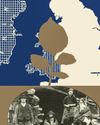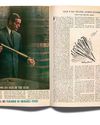
Chop down a poplar tree. Other kinds of wood could work, too, but poplar is an especially soft one, and your task is to trim it into thin planes. These you'll need to coat in a barrier of plaster and animal gluenaked wood is highly absorbent, and you can't have it drinking down everything you put on it. Wait until the barrier has dried. Sand. Repeat until you have a perfectly smooth surface.
Sketch your preferred silhouettes with a stick of charcoal, slather the negative space in a gluey reddish mixture, cover that in translucent gold leaf (glueless, the metal has a queasy green tinge), and burnish that with a wolf's tooth. Now, and only now, you may pick up your brush.
The Met's new show about what happens next, "Siena: The Rise of Painting, 1300-1350," makes clear how astonishing it is that paint, of all things, became the center of Western art. Gold was prettier. Wood was tougher. Textile and ivory, both well represented here, travelled from city to city more freely. Nobody ever looked at an egg yolk, the signature ingredient in tempera, and thought "sublime," let alone "enduring," but here we are, seven centuries later. There may never be another big American exhibition about this freakish little era, when artists figured out how to make colorful ooze do their bidding.
هذه القصة مأخوذة من طبعة October 28, 2024 من The New Yorker.
ابدأ النسخة التجريبية المجانية من Magzter GOLD لمدة 7 أيام للوصول إلى آلاف القصص المتميزة المنسقة وأكثر من 9,000 مجلة وصحيفة.
بالفعل مشترك ? تسجيل الدخول
هذه القصة مأخوذة من طبعة October 28, 2024 من The New Yorker.
ابدأ النسخة التجريبية المجانية من Magzter GOLD لمدة 7 أيام للوصول إلى آلاف القصص المتميزة المنسقة وأكثر من 9,000 مجلة وصحيفة.
بالفعل مشترك? تسجيل الدخول
Techniques and cIdiosyncrasies

FEAR FACTOR
How the Red Scare reshaped American politics.

PLAYTIME
The old film studios had house styles: M-G-M’s was plush and sentimental, Warner Bros.’ stark and intense.

TIME AND PLACE
“Tatlin: Kyiv” explores a Russian Constructivist’s Ukrainian identity.

MOURNING BECOMES HER
Akram Khan’s “Gigenis: The Generation of the Earth.”

TEXAS ROUNDUP
How Greg Abbott made his state the staging ground for Donald Trump's mass-deportation campaign.

HOUSE CALL
To rent or to buy is the eternal question.

INDESCRIBABLE
The human disaster of the Irish famine.

Louisa Thomas on John Updike's "Hub Fans Bid Kid Adieu"
The original idea was an assignation. On a dreary Wednesday in September, 1960, John Updike, \"falling in love, away from marriage,\" took a taxi to see his paramour.

LIP SERVICE
Zyn and the new nicotine gold rush.